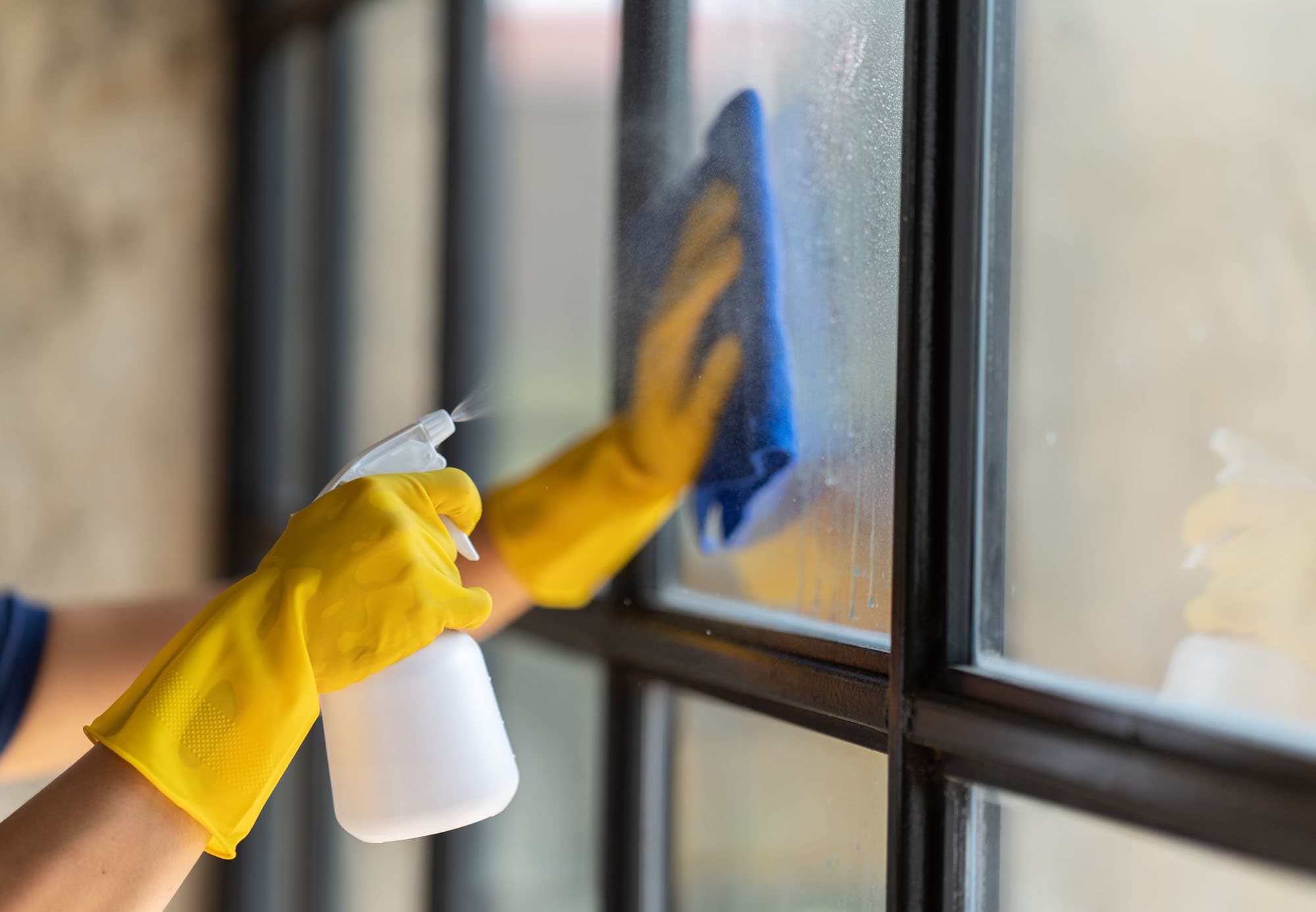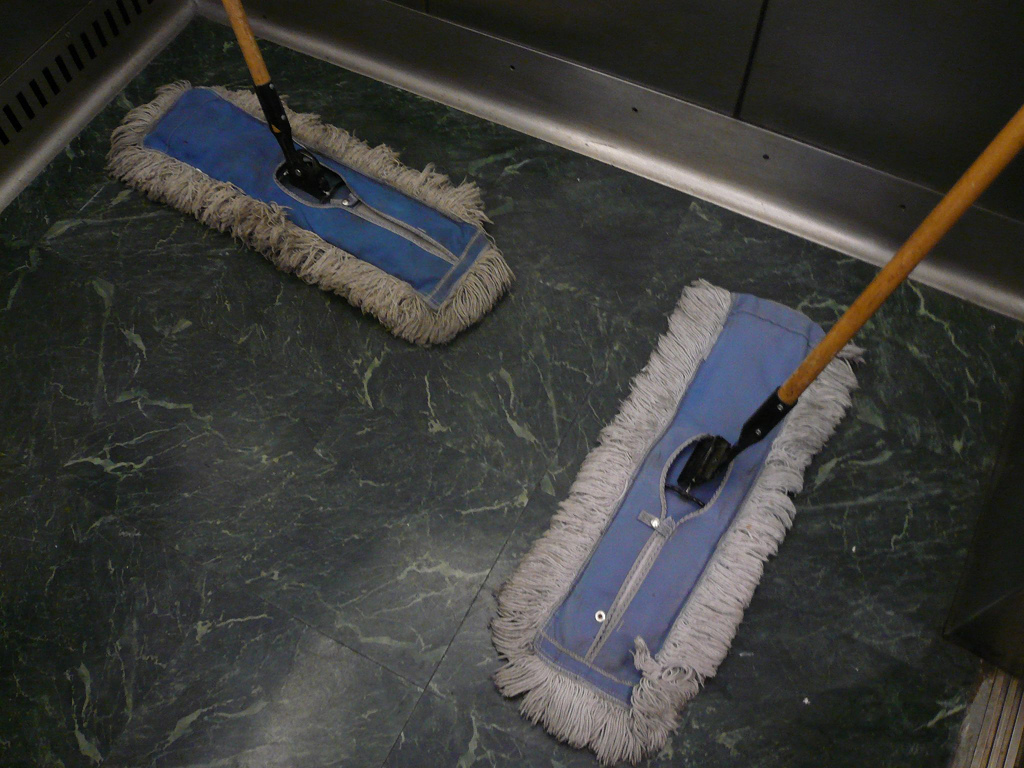To decide whether to make your floors shine again or just clean them up, assess their condition. If they’re dull and scratched, a polish might be necessary for a fresh look. However, if they’re just dirty, a thorough clean will suffice. Regular maintenance can enhance your floors’ appearance and prolong their life, so consider your time and budget. You might want to explore factors influencing your choice and tips for the best results.
Understanding Different Flooring Types
When it comes to floor cleaning, understanding the different flooring types is essential for choosing the right method and products. Each type—hardwood, tile, carpet, or laminate—requires a unique approach.
For hardwood, you’ll want gentle cleaners that won’t strip the finish. Tile can handle more robust products, especially in grout lines. Carpets benefit from deep cleaning methods, like steam cleaning, to remove embedded dirt and allergens.
Laminate floors need special care with non-abrasive solutions to avoid damaging the surface. By identifying your flooring type, you can select the most effective cleaning strategy, ensuring a safe and thorough clean.
This knowledge ultimately helps you serve your home and loved ones better, creating a healthier and more inviting environment.
Assessing the Condition of Your Floors
To keep your floors looking their best, you need to assess their condition regularly.
Start with a visual inspection to spot any signs of wear and tear, and consider the type of surface material you’re dealing with.
This simple check can help you determine the right cleaning approach for your floors.
Visual Inspection Techniques
A thorough visual inspection is essential for evaluating the condition of your floors. By closely examining them, you can determine whether they need a simple cleaning or a more intensive restoration.
Here are four key aspects to reflect upon during your inspection:
Surface Damage: Look for scratches, dents, or cracks that may require repair.
Stains: Identify any stubborn stains that cleaning mightn’t remove easily.
Discoloration: Notice any uneven fading or discoloration that could indicate wear.
Cleanliness: Assess the overall cleanliness, including dust, dirt, or grime buildup.
Surface Material Considerations
While inspecting your floors, it’s crucial to take into consideration the specific surface material, as each type has unique care requirements and vulnerabilities.
For example, hardwood floors need gentle cleaning solutions and regular polishing to maintain their luster. On the other hand, tile and vinyl are often more durable but may require different approaches to avoid damage.
If you have carpet, you’ll want to contemplate deep cleaning methods to lift embedded dirt. Understanding these nuances helps you serve your space better.
By tailoring your cleaning approach to the material, you not only extend the life of your floors but also create a welcoming environment for those who step into your home.
Prioritize the right care to truly make a difference.
Wear and Tear Signs
As you navigate your home, noticing signs of wear and tear on your floors is essential for maintaining their overall condition.
Recognizing these signs early helps you serve your space better and prolong its life.
Here are four key indicators to watch for:
Scratches and Scuff Marks: Look for surface damage that may detract from your floors’ beauty.
Discoloration: Notice any fading or stains that could signal deeper issues.
Creaking or Loose Boards: Pay attention to any sounds or movement that suggest structural problems.
Uneven Surfaces: Feel for any bumps or dips that can affect safety and aesthetics.
The Importance of Regular Maintenance
Regular maintenance is key to keeping your floors looking great and lasting longer.
By staying on top of cleaning, you can prevent long-term damage and enhance their aesthetic appeal.
Plus, it often turns out to be a cost-effective solution in the long run.
Preventing Long-Term Damage
To keep your floors looking their best, consistent maintenance is essential.
Regular care not only enhances their appearance but also prevents long-term damage, saving you time and money in the long run.
Here are four key practices to incorporate into your routine:
Sweep or Vacuum Regularly: Remove dirt and debris to prevent scratches.
Mop with Care: Use a damp mop with appropriate cleaners to avoid buildup.
Address Spills Immediately: Wipe up spills promptly to prevent staining and damage.
Use Furniture Pads: Protect your floors from scratches caused by heavy furniture.
Enhancing Aesthetic Appeal
While it might seem like a hassle, maintaining your floors regularly greatly enhances their aesthetic appeal.
Just think about how much joy a clean, shiny floor brings to your home or business. When you take the time to care for your floors, you create a welcoming atmosphere for guests and clients alike.
Regular maintenance helps prevent dirt buildup and keeps your floors looking their best, reflecting your commitment to quality and care. Plus, a polished floor can elevate the overall design of any space, making it feel more inviting and elegant.
Cost-Effective Maintenance Solutions
Though you might think that floor maintenance requires a hefty investment, there are plenty of cost-effective solutions that make it manageable.
Regular maintenance not only keeps your floors looking great but also extends their lifespan, ultimately saving you money.
Here are four practical tips:
Sweep and mop regularly – Keeping dirt at bay prevents scratches and wear.
Use homemade cleaners – Simple mixtures of vinegar and water can be effective and budget-friendly.
Invest in entry mats – These trap dirt before it enters your home, reducing cleaning time.
Schedule routine inspections – Early detection of issues can prevent costly repairs later on.
Cleaning vs. Polishing: What’s the Difference?
Understanding the difference between cleaning and polishing is essential for maintaining your floors effectively.
Cleaning involves removing dirt, dust, and grime, guaranteeing your floors are hygienic and presentable. You can achieve this through mopping, sweeping, or using specialized cleaning solutions.

On the other hand, polishing focuses on enhancing your floors’ appearance, providing a protective layer that adds shine and luster. Polishing helps to minimize scratches and wear, making your floors look brand new.
While cleaning is a regular task, polishing is typically done periodically to maintain that desired shine. Knowing when to clean and when to polish will help you serve others better, creating a welcoming atmosphere in your home or business.
Prioritizing both tasks guarantees your floors stay beautiful and functional.
Factors to Consider Before Making a Decision
Before deciding on the best floor cleaning method, consider several key factors that can impact your choice.
Understanding these elements will help you serve your space and community better.
Floor Material: Different materials require specific cleaning techniques to avoid damage.
Traffic Levels: High-traffic areas may need more thorough cleaning or polishing to maintain appearance.
Time Commitment: Assess how much time you can dedicate to cleaning versus polishing.
Desired Results: Think about whether you want a simple clean or a shiny, polished look that reflects your commitment to a welcoming environment.
Cost Implications of Cleaning vs. Polishing
Choosing between cleaning and polishing your floors not only depends on the factors you’ve considered but also on your budget.
Cleaning is generally more affordable and requires less time, making it a practical choice for regular maintenance. You can often tackle it yourself or hire a service at a reasonable cost, helping you serve your space effectively.
On the other hand, polishing involves additional expenses, including specialized products and possibly professional help.
While polishing can enhance your floors’ appearance, it’s crucial to weigh whether the shine is worth the extra investment.
Ultimately, understanding your budget and the long-term benefits of each option will guide you in making the right choice for your home and those you serve.
DIY vs. Professional Services
While you might enjoy the satisfaction of a clean floor from a DIY effort, sometimes professional services can save you time and yield better results.
Choosing between DIY and hiring professionals depends on your needs and situation. Here are some points to evaluate:
Expertise: Professionals have the knowledge and experience to tackle tough stains and types of flooring.
Equipment: They use specialized tools and products that you mightn’t have access to at home.
Time-saving: Hiring a service frees up your schedule, allowing you to focus on other important tasks.
Quality: Professionals often deliver a level of shine and cleanliness that’s hard to achieve on your own.
Ultimately, reflect on what serves you best in your circumstances.
Tips for Maintaining Shine After Cleaning
To keep your floors looking their best after a thorough cleaning, it’s essential to adopt a regular maintenance routine.
Start by sweeping or vacuuming daily to remove dirt and debris. This will prevent scratches and dullness.
Use a damp mop weekly, but avoid excess water, as it can damage some floor types. For a bit of shine, consider using a floor polish that’s compatible with your floor material every few months.
Additionally, place doormats at entryways to trap dirt before it enters your home. Encourage family and guests to remove shoes indoors; this simple habit can greatly extend your floors’ shine.
Making the Right Choice for Your Home
Maintaining that shine is just one part of the equation when it comes to floor care; selecting the right flooring for your home plays a significant role in both aesthetics and functionality.
You want to guarantee that your choice aligns with your lifestyle and the needs of those you serve.
Consider these four factors:
Durability: Choose a material that withstands everyday wear and tear.
hose cleaningMaintenance: Opt for flooring that’s easy to clean and maintain, saving you time.
Comfort: Think about how the flooring feels underfoot, especially for kids and elderly guests.
Style: Select a design that complements your home’s decor and creates a welcoming atmosphere.
Making the right choice enhances not just your space but also the lives of those who inhabit it.
Frequently Asked Questions
How Often Should I Clean My Floors for Optimal Maintenance?
You should clean your floors at least once a week for ideal maintenance. Regular cleaning not only keeps them looking great but also prevents dirt buildup, making it easier to serve others in a welcoming environment.
Can I Use Regular Cleaners on All Floor Types?
You can’t use regular cleaners on all floor types. Each material requires specific products to avoid damage. Always check the manufacturer’s guidelines to verify you’re using the right cleaner for best results and longevity.
What Are the Signs That My Floors Need Polishing?
You’ll notice your floors looking dull, scratched, or scuffed. If light reflections seem weak or dirt accumulates despite cleaning, it’s time to polish. Keeping them beautiful enhances your space and impresses those you serve.
Is It Safe to Mix Cleaning Products for My Floors?
Mixing cleaning products can be like dancing with fire—exciting but risky. Stick to one product at a time, and you’ll keep your floors safe and your service to others shining bright without any hazards lurking.

How Long Does Floor Polishing Typically Last?
Floor polishing usually lasts anywhere from six months to two years, depending on traffic and maintenance. Regular cleaning and timely touch-ups can extend its life, ensuring your floors always look inviting for those you serve.
Conclusion
In the end, whether you choose to make your floors shine like new or simply clean them up, both options have their merits. If you’re after a fresh, polished look, go for polishing; but if you’re more about practicality and ease, a thorough clean might suit you better. Remember, regular maintenance is key to keeping your floors in shape, so weigh your choices wisely. After all, a little care today can save you a lot of hassle tomorrow!